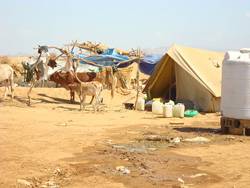|
|
Livestock Losses Hit IDP Livelihoods
IRIN
May 2, 2010
Yemen

According UNHCR, 30 percent of IDPs came to Mazraq camps in northern Yemen with their animals
Thousands of families who lost their livestock in the last round of clashes between the Yemeni army and Houthi-led rebels in the northern governorates of Saada and Amran are at risk of becoming food insecure, according to local officials and aid workers.
Hundreds of families in Amran’s Harf Sufyan district fled the conflict between August 2009 and February 2010 leaving their animals behind, according to Yahya Abdullah, a local councilor.
"Some of the families who returned home in mid-March saw only skeletons of their animals inside stables," he said. "Others didn't find any remnants of their animals, which indicates they had been stolen. Now, those people face difficulty feeding their children."
Similarly, many displaced families in the Mazraq camps for internally displaced persons (IDPs) in Haradh district, in the northwestern Governorate of Hajjah, were forced to leave their animals behind or sell them at a very low price.
“We sold our cow and 16 of our 30 goats on our way to the camp at a very low price of YR140,000 [US$650]. We gave the other 14 goats to a broker to sell,” Mohammed Munif al-Saadi, 75, a resident of Mazraq Camp II, told IRIN. They fled their home in Bani Saad village in al-Dhahir district in northern Saada in mid-August 2009 and are now running out of the money they got from selling their livestock.
“We spent the money on buying milk powder for our grandchildren and covering other needs. The broker whom we gave the goats to sell has disappeared. When I went to al-Talh Market to look for him, people told me he was killed in an airstrike on the market in October 2009,” al-Saadi said.
Impact of livestock losses
A flash appeal by the UN Food and Agriculture Organization (FAO) in December 2009, said that reduced productivity and livestock losses would have a devastating impact on the availability of food and on current and future livelihoods.
It said that weakened and sick animals required immediate veterinary assistance in order to prevent the further loss of productive assets, which are indispensable to vulnerable groups in both the immediate and long term.
Agriculture, particularly livestock, is the primary source of income for many families in Yemen’s conflict-affected areas, where 80-90 percent of the population are rural inhabitants, according to the government's Central Statistical Organization.
Over 70 percent of Yemenis rely on crop and livestock production to earn a living and to meet their basic food needs, according to FAO.
According to a survey conducted by FAO in January 2010 in Amran Governorate, about 3,250 IDP families lost over 50 percent (some 35,300 heads) of their livestock. The survey found that the livestock had died, been sold or had been stolen and that remaining animals were in need of urgent assistance.
“FAO currently has some funding [$350,000] and is effecting a screwworm eradication programme and buying further veterinary inputs and fodder for distribution within the coming few days,” Paul Schlunke, Emergency Coordinator with FAO, told IRIN.
Fleeing with animals
According to estimates by the UN Refugee Agency (UNHCR), 30 percent of displaced families in the Mazraq area arrived with their livestock.
The UN’s 2010 Yemen Humanitarian Response Plan (YHRP) warned that migrating livestock under poor sanitary conditions increased the risk of transboundary and zoonotic disease outbreaks.
Local NGO Triangle is assisting close to 15,000 animals owned by 1,500 IDP families in the Mazraq area with funds from UNHCR.
Protecting the livestock of IDPs not only secures their livelihoods, but maintains the food security status of households, particularly regarding the nutrition of pregnant and nursing women and young children who are in need of milk for their well-being and development, said Schlunke.
"This will help reduce their dependency on aid and encourage them to return to their farms when peace is assured,” he said.
|
|



